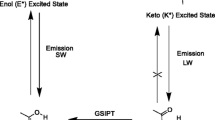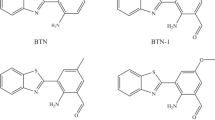Abstract
The ground state (S0) geometry of the firefly luciferin (LH2) was optimized by both DFT B3LYP and CASSCF methods. The vertical excitation energies (T v) of three low-lying states (S1, S2, and S3) were calculated by TD-DFT B3LYP//CASSCF method. The S1 geometry was optimized by CASSCF method. Its T v and the transition energy (T e) were calculated by MS-CASPT2//CASSCF method. Both the TD-DFT and MS-CASPT2 calculated S1 state T v values agree with the experimental one. The IPEA shift greatly affects the MS-CASPT2 calculated T v values. Some important excited states of LH2 and oxyluciferin (oxyLH2) are charge-transfer states and have more than one dominant configuration, so for deeply researching the firefly bioluminescence, the multireference calculations are desired.
Similar content being viewed by others
References
Wilson T. Comments on the mechanism of chemi-and bioluminescence. Photochem Photobiol, 1995, 62: 601–606
Hastings J W. Bioluminescence, In: Sperelakis N, ed. Cell Physiology Source Book. New York: Academic Press, 1995. 665–681
Wood K V. Chemical mechanism and evolutionary development of beetle bioluminescence. Photochem Photobiol, 1995, 62: 662–673
Hastings J W. Chemistries and colors of bioluminescent reactions-a review. Gene, 1996, 173: 5–11
Subramani S, deLuca M. Applications of the firefly luciferase as a reporter gene. In: Setlow J, Hollaender A, eds. Genetic Engineering—Principles and Practice Vol 10. New York: Plenum Press, 1988. 75–89
White E H, Rapaport E, Seliger H H, Hopkins T A. The chemi-and bioluminescence of firefly luciferin: an efficient chemical production of electronically excited states. Bioorg Chem, 1971, 1: 92–122
Branchini B R, Murtiashaw M H, Magyar R A, Portier N C, Ruggiero M C, Stroh J G. Yellow-green and red firefly bioluminescence from 5,5-dimethyloxyluciferin. J Am Chem Soc, 2002, 124: 2112–2113
Ugarova N N, Brovko L Y. Protein structure and bioluminescent spectra for firefly. Bioluminescence Luminescence, 2002, 17: 321–330
McCapra F, Gilfoyle D J, Young D W, Church N J, Spencer P. The chemical origin of colour differences in beetle bioluminescence. In: Campbell A K, Kricka L J, Stanley P E, eds. Bioluminescence and Chemiluminescence: Fundamentals and Applied Aspects. New York: John Wiley & Sons, 1994. 387–391
Brovko L Y, Gandelman O A, Savich W I. Fluorescent and quantum-chemical evaluation of emitter structure in firefly bioluminescence. In: Campbell A K, Kricka L J, Stanley P E, eds. Bioluminescence and Chemiluminescence: Fundamentals and Applied Aspects. Chichester: Wiley, 1994. 525–527
Orlova G, Goddard J D, Brovko L Y. A theoretical study of amazing firefly bioluminescence: The structure of the light emitters. J Am Chem Soc, 2003, 25: 6962–6971
DeLuca M. Hydrophobic nature of the active site of firefly luciferase. Biochemistry, 1969, 8: 160–166
Ugarova N N, Brovko L Y. Relationship between the structure of the protein globule and bioluminescence spectra of firefly luciferase. Russian Chem Bull, 2001, 50: 1752–1761
Gandelman O A, Brovko L Y, Ugarova N N, Chikishev A Y, Shkurimov A P. Oxyluciferin fluorescence is a model of native bioluminescence in the firefly luciferin luciferase system. J Photochem Photobiol B: Biol, 1993, 19: 187–191
McElroy W D, Seliger H H. The colors of bioluminescence: Role of enzyme and substrate structure. In: Hayashi H, Szent-Gyorgyi I, eds. Molecular Architecture in Cell Physiology. Englewood Cliffs: Prentice Hall, 1966. 63–80
Branchini B R, Southworth T L, Murtiashaw M H, Magyar R A, Gonzalez S A, Ruggiero M C, Stroh J G. An alternative mechanism of bioluminescence color determination in firefly luciferase. Biochemistry, 2004, 43: 7255–7262
Wada N, Honda M, Yoshihara T, Suzuki H. Theory of d-luciferin in ethanol. J Phys Soc Jpn, 1980, 49: 1519–1523
Nakatsu T, Ichiyamal S, Hiratake J, Saldanha A, Kobashi N, Sakata K, Kato H. Structural basis for the spectral difference in luciferase bioluminescence. Nature, 2006, 440: 372–376
Kohn W, Sham L J. Self-consistent equations including exchange and correlation effects. Phys Rev, 1965, 140: A1133–A1138
Becke A D. Density-functional thermochemistry III. The role of exact exchange. J Chem Phys, 1993, 98: 5648–5652
Lee C, Yang W, Parr R G. Development of the colle-salvetti correlation-energy formula into a functional of the electron density. Phys Rev B, 1988, 37: 785–789
Casida M E, Jamorski C, Casida K C, Salahub D R. Molecular excitation energies to high-lying bound states from time-dependent density-functional response theory: Characterization and correction of the time-dependent local density approximation ionization threshold. J Chem Phys, 1998, 108: 4439–4449
Rassolov V A, Ratner M A, Pople J A, Redfern P C, Curtiss L A. 6-31G* basis set for third-row atoms. J Comp Chem, 2001, 22: 976–984
Frisch M J, Trucks G W, Schlegel H B, Scuseria G E, Robb M A, Cheeseman J R, Zakrzewski V G, Montgomery J A, Jr., Stratmann R E, Burant J C, Dapprich S, Millam J M, Daniels A D, Kudin K N, Strain M C, Farkas O, Tomasi J, Barone V, Cossi M, Cammi R, Mennucci B, Pomelli C, Adamo C, Clifford S, Ochterski J, Petersson G A, Ayala P Y, Cui Q, Morokuma K, Malick D K, Rabuck A D, Raghavachari K, Foresman J B, Cioslowski J, Ortiz J V, Baboul A G, Stefanov B B, Liu G, Liashenko A, Piskorz P, Komaromi I, Gomperts R, Martin R L, Fox D J, Keith T, Al-Laham M A, Peng C Y, Nanayakkara A, Challacombe M, Gill P M W, Johnson B, Chen W, Wong M W, Andres J L, Gonzalez C, Head-Gordon M, Replogle E S, Pople J A. Gaussian 98, Revision A.9, Gaussian, Inc., Pittsburgh PA, 1998
Roos B O, Taylor P R, Siegban P E M. A complete active space SCF method (CASSCF) using a density matrix formulated super-CI approach. Chem Phys, 1980, 48: 157–173
Roos B O, Andersson K, Fulscher M P, Malmqvist P A, Serrano-Andres L, Pierloot K, Merchan M. Multiconfigurational perturbation theory: Applications in electronic spectroscopy. In: Prigogine I, Rice S A, eds. Advances in Chemical Physics: New Methods in Computational Quantum Mechanics. New York: John Wiley & Sons, 1996, XCIII: 219–331
Roos B O, Lindh R, Malmqvist P Å, Veryazov V, Widmark P O. Main group atoms and dimers studied with a new relativistic ANO basis set. J Phys Chem A, 2004, 108: 2851–2858
Jansen G, Hess B A. Revision of the Douglas-Kroll transformation. Phys Rev A, 1989, 39: 6016–6017
Karlström G, Lindh R, Malmqvist P Å, Roos B O, Ryde U, Veryazov V, Widmark P O, Cossi M, Schimmelpfennig B, Neogrady P, Seijo L. Molcas: A program package for computational chemistry. Computational Material Science, 2003, 28: 222–239
Dennis D, Stanford R H Jr. The crystal and molecular structure of firefly D(-)-luciferin. Acta Cryst, 1973, B29: 1053–1058
Kobayashi R, Amos R D. The application of CAM-B3LYP to the charge-transfer band problem of the zincbacteriochlorin-bacteriochlorin com. Chem Phys Lett, 2006, 420: 106–109
Tozer D J, Amos R D, Handy N C, Roos B O, Serrano-Andrés L. Does density functional theory contribute to the understanding of excited states of unsaturated organic compounds? Mol Phys, 1999, 97: 859–868
Ghigo G, Roos B O, Malmqvist P Å. A modified definition of the zeroth order Hamiltonian in multiconfigurational perturbation theory (CASPT2). Chem Phys Lett, 2004, 396: 142–149
Author information
Authors and Affiliations
Corresponding author
Additional information
Supported by the National Natural Science Foundation of China (Grant No. 20673012) and the Major State Basic Research Development Programs (Grant No. 2004CB719903)
Rights and permissions
About this article
Cite this article
Liu, Y., Fang, W. Ab initio investigation on the structures and spectra of the firefly luciferin. Sci. China Ser. B-Chem. 50, 725–730 (2007). https://doi.org/10.1007/s11426-007-0127-4
Received:
Accepted:
Issue Date:
DOI: https://doi.org/10.1007/s11426-007-0127-4




